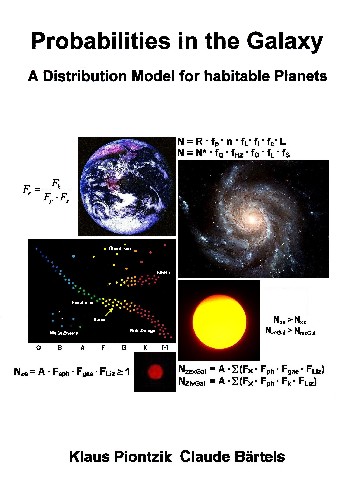 |
If only the
planets are considered, an equation for the
probability of a habitable planet can be
established in any star system. |
| |
|
| 8.2.1 Definition |
Fph
= Fp
· Fh |
So you can use the rounded values.
Fph = 201:14,000 · 10:603
Fph
= 1:4200
Among 4200 star systems there is probably one that has
planets, at least one of which is a habitable planet.
Then applies to the set of all star systems of a spectral
class that possess habitable planets:
| 8.2.2 Equation |
Nphx
= NX ·
Fph
Nphx
= A · FX ·
Fph |
It is important here that all
factors can be determined in the long term by appropriate
instruments of observation, i.e. empirically. According
to theorem 6.1.2, this should be the case in the next two
centuries.
The set of all star systems NphxGal
in the galaxy, with planets and at least one in the
habitable zone, is then the sum of all spectral classes:
| |
NphxGal
= ∑ Nphx
= ∑ (A · FX ·
Fph) |
Since A remains the same for all
spectral classes, A can be taken from
the sum:
| 8.2.3 Equation |
NphxGal
= ∑ Nphx
= A · ∑ (FX ·
Fph) |
Strictly speaking, the
probabilities Fp and Fh and thus Fph
would have to be determined individually for each
spectral class.
However, since this is not yet possible, a rough
calculation or maximum estimate can be achieved by
assuming the same or similar frequencies of the planetary
distributions in the spectral classes in a first
approach.
If one assumes, in a first assumption, that other star
systems, i.e. not sun-like stars, also have the same or
similar planetary distribution, one can calculate how
many systems could exist with habitable planets at most.
| 8.2.4 Approach |
In star systems that are not
sun-like, there are probably the same or similar
distributions, for habitable planets, as in
sun-like systems. |
Provided that Fp and Fh
remain the same for all spectral classes (approach
8.2.4), they can also be drawn from the sum (equation
8.2.3):
| |
NphxGal
= ∑ Nphx
= A· Fph
· ∑ (FX) |
The sum of all spectral classes
(for the probabilities FX)
results in the totality of the stars in the galaxy:
This results approximately from the
approach 8.2.4:
| 8.2.5 Equation |
NphxGal
≈ A · Fph |
Starting point are 100-300 billion
solar systems, in the galaxy, and inserting all values
into equation 8.2.5 results:
| 8.2.6 Theorem |
The
quantity of all star systems in the galaxy with
planets and at least one in the habitable zone is
probably a maximum of 23.81 to 71.428 million. |
|
